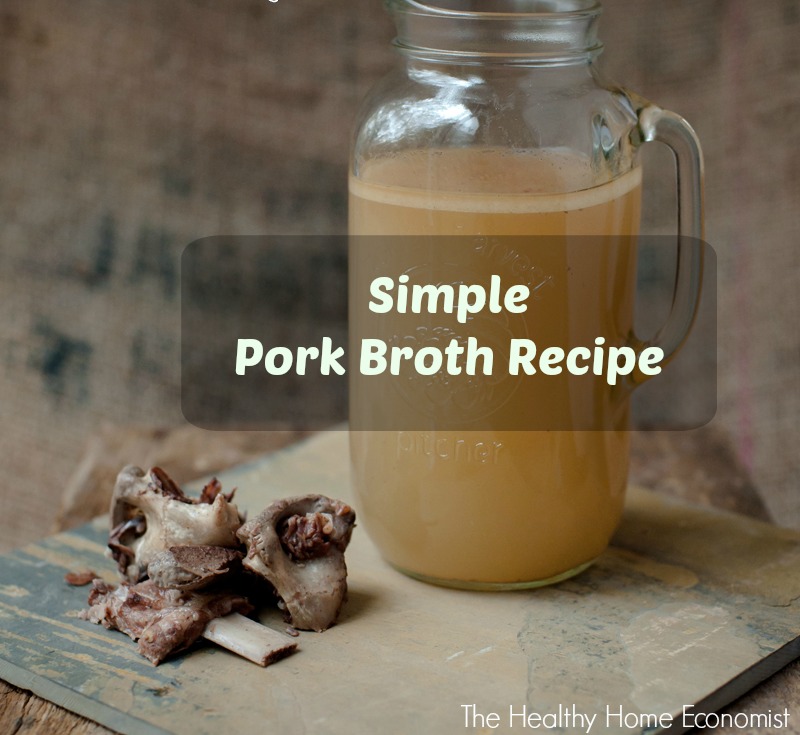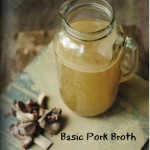 Making homemade bone broth is a crucial technique a Traditional Cook must master. Ideally, it is made at least once a week. Since quality bones are expensive, is pork broth an option? Most people have never considered it. Quality pastured pork at affordable prices is widely available in many communities. Let’s examine this question below.
Making homemade bone broth is a crucial technique a Traditional Cook must master. Ideally, it is made at least once a week. Since quality bones are expensive, is pork broth an option? Most people have never considered it. Quality pastured pork at affordable prices is widely available in many communities. Let’s examine this question below.
Health Requires Lots of Bone Broth – Why Not Pork?
I make a large pot of stock once or twice every week. Our family flies through quarts of it so quickly at mealtimes! A ready supply of gelatin and mineral rich broth in the freezer is also important when illness strikes. This nutrient rich food is a key player for rapid recovery without meds. This is especially true when a fever is involved.
Commercial Broth vs Homemade Broth
Getting sick and realizing there is no homemade bone broth is a devastating feeling, I can assure you! Simply running out to the store to pick up some canned soup or broth in a carton is not going to solve the problem. These industrially produced products even if organic are just water and MSG with little to no nutrient value and certainly no gelatin!
Even the properly made commercial bone broths available in recent years are not comparable to homemade. They are all watered down (every single brand I’ve tested). What’s worse, they are usually packaged in toxic plastic or plastic lined tetrapaks. The broth is boiling hot when it is poured into the containers if the product is shelf stable. Try it yourself. Put them in the refrigerator. They don’t gel like broth made at home does. The only brand worth buying is Epic bone broth in glass jars, but unfortunately it is still watered down.
Making your own broth has no substitute!
There is nothing worse than a tummy bug striking your children and knowing that a pot of gelatin rich stock that will halt the illness in its tracks is a full 24-48 hours away. Unless, of course, you can quickly source the right kind of fishheads, then a pot of stock can be ready in as little as 4 hours.
Pork Broth More Affordable than Most
With plenty of stock on hand for whatever your cooking or wellness needs might be, the next question is how to source quality bones at a price that is within a typical family’s food budget.
The highest quality pastured pork bones for making pork stock tend to cost between one half and three quarters as much as grassfed beef bones or pastured chicken in my experience, particularly if you source an entire hog.
Some might question how pork bones could make good pork broth given the fattiness of the meat. Culinary purists believe that soups and sauces made with fatty stock do not yield the best results. This problem is easily remedied by chilling pork stock in the refrigerator which allows the congealed pork fat to be removed from the top of the container of stock with a spoon.
If you’ve never tried pork broth or pork stock before, why don’t you give it a try? Here is a very simple and basic pork broth recipe to get you going. It is inspired by the beautiful book Beyond Bacon, Paleo Recipes that Respect the Whole Hog, by Stacy Toth and Matthew McCarry.
How to Make Pork Broth (Pork Stock)
The recipe for pork stock below makes about 2 quarts. Try it with your next batch! I’m sure you’re going to love it!


Pork Broth Recipe
How to make pork broth that is a affordable, nutritious, and delicious alternative to other more expensive stocks made with pastured poultry or grassfed beef bones.
Ingredients
- 3 lbs pastured pork bones
- 1 Tbl apple cider vinegar raw and unfiltered, preferably organic
- ground peppercorns
- sea salt
Instructions
-
Put all of the bones in a stockpot and add enough filtered water to cover.
Cook on high until the water comes to a boil and scum rises to the top. Cook for 5 minutes.
Dump the entire pot of water and refill with fresh filtered water, enough to cover the bones. Mix in the apple cider vinegar and bring the water to a boil once again.
Carefully skim off any foam that comes to the top. It should be minimal given that the water with most of the scum was dumped in the previous step.
Reduce heat and simmer on low for 9-24 hours.
Remove the pot from the heat, strain and taste. Add salt and pepper as needed. Let cool and then refrigerate in one or more airtight containers.
Skim the lard off the top of the chilled pork broth the following day and refrigerate. Reserve this delicious fat high in Vitamin D for cooking. This article plus video provides more information on how to render lard.
Use the clarified pork stock as the base for soups and sauces the same as you would use chicken or beef stock.
Sarah, The Healthy Home Economist








Not sure where the ‘culinary experts’ get the idea that fatty bones and meats do not make tasty bone broth or stock. Ramen shops in Asia have a long tradition of using pork, and other fatty meat/bones like duck, to make the most delicious long and slow simmered bases for their famous and fabulous noodle/soup bowls. Thank you for posting the process for all the various animal bone broths. I plan to try all of them now that I have found a source for pasture and free forage raised pork (pigs feet), poultry (especially chicken feet – like my grandmother used), beef, duck, and bison. I am not sure about trying lamb, as it is a much stronger flavor than all the others, but, you never know. I am most interested in trying bone broth using fish bones.
I’ve been using smoked pork neck bones to make my broth for years. I make a large pot of kale seasoned with smoked pork neck bones. I save all the bones and use them to make the broth. This broth makes a great chicken soup base as well as a great vegetable beef base. I have never used vinegar, nor did I ever noticed scum at the top of my pot on the stove. I thankfully now have a 10qt pressure cooker and now I make 10qts plain broth and 10qts vegetable seasoned broth. It keeps wonderfully in the deep freezer until ready to use, so do the bones I save. Happy broth making!
I understand the immediately revolting reaction. I really do, but don’t be so quick to oppose. After a full night of simmering, most of the acetic acid has reacted to the basic compounds leeched from the bones. It softens the bones and makes sure that you’re able to pull a lot more of the minerals that would otherwise be stuck inside the bone.
What chefs would classically do is soak the bones overnight in either pure vinegar or a high vinegar solution to soften the bone. That way, more of it would fall apart, dissolving the collagen from the bone in the broth. You can tell a bone has been used up when it gets soft and brittle. The small amount of vinegar used here isn’t actually for flavor. It’s just for chemistry. 🙂
I just made some today and the broth is so rich and a little spicy (added some) it actually tastes like hot and sour soup broth, so I’m keeping this one and adding some fresh ingredients tomorrow. Should be a good appetizer.
Non-traditional animal parts are often excellent sources of collagen. If you are sourcing a pastured animal why not try the cockscomb and feet of the chicken? Very old classic French recipes required such things.
Hocks and neck bones work well for this one. Don’t dump the water and refill, just let it simmer. And for gods sake no vinegar! yuck
I have waisted time and money as well! Thought I was the only one! I recently found a good deal on pasture raised heritage pork bones and then went into a panick because I’ve never seen any recipes for pork bone broth. Do you get it to Joe using a pressure cooker or a slow cooker or a stock pot?
I just made pork broth this week. I used the spine and the back hip joints– congealed great. I didn’t skim the fat off- but I never do on my broths as the fat adds flavor. I also don’t freeze my broth– I pressure can it.
Pressure cooking is not how MSG is formed at all. So long as you have a quality pressure cooker that won’t explode, it’s perfectly safe. Plus double-blind studies have failed to show any evidence that MSG causes headaches, and the sensitivity is usually to sodium itself, not MSG.
Try using pig tails and pig feet. I’ve wasted a lot of time and money on just using bones for bone broth that never gelled. I started using bones that have a lot of collagen like pig/chicken feet, pig tails, and beef knuckles!! Nothin but healthy jelloo